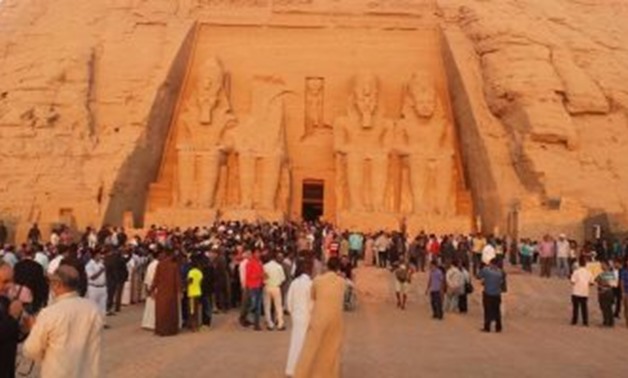
File - Abu Simbel Temple.
CAIRO - 15 February 2020: Ministry of Antiquities and Tourism started preparing for the celebrations of the marvelous phenomenon of the solar illumination of King Ramses II which will take place on February 22.
Ramses II solar alignment phenomenon occurs twice annually; on February 22 and October 22, where the sun rays fall on the temple and lighten a part of the inner walls.
For most of the year, the inner sanctum of the main temple at Abu Simbel is almost completely dark. But only twice annually sunlight lightens the seated statues of the sun gods Re-Horakhte and Amon-Re, in addition to Ramses II's statue.
Many tourists gathered in Abu Simbel Temple every year to observe the sun rays falling on the temple’s statues.
The temple complex of Abu Simbel is one of the most popular monumental buildings in Aswan, which is located at the second cataract of the Nile River.
The temple, carved out of a sandstone cliff on the west bank of the Nile, was discovered twice. It was initially discovered in 1813 by Swiss researcher Johann Ludwig Burckhardt, and then rediscovered in 1817 by Egyptologist Govani Battista.
At the entrance of Abu Simbel temple, there are two seated statues of the Pharaoh, showing the ruler with a short kilt, a beautiful headdress which is a double crown with a cobra and a false beard.
Next to the statues’ legs, are smaller statues of the Pharaoh’s relatives. A row of 22 squatting baboon statues is placed at the top of the temple. The baboon’s cry was believed to welcome the rising sun.
Inside the temple, there are images and hieroglyphics, describing Ramses II’s victory at the battle of Qadesh, in addition to empty store rooms.
According to many scholars, this great temple was created to celebrate the victory of Ramses II over the Hittites at the Battle of Qadesh in 1274 BC.
This means that the temple was situated on the border of the conquered lands of Nubia after many military campaigns were carried out by the Pharaoh against Nubia.
Abu Simbel is made up of two temples. The smaller one was built for Queen Nefertari and has two statues of her and four pharaohs; each about 33 feet (10 meters) in height.
Ramses II built this temple to impress Egypt's southern neighbors, and also to reinforce the status of the Egyptian religion in the area. Abu Simbel was one of six rock temples erected in Nubia during the ruling period of Ramses II and its construction took 20 years from 1264 BC to 1244 BC.
Comments
Leave a Comment